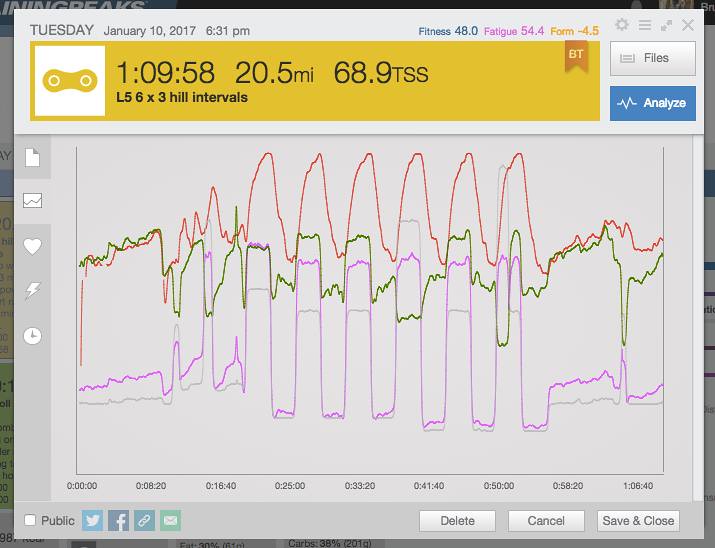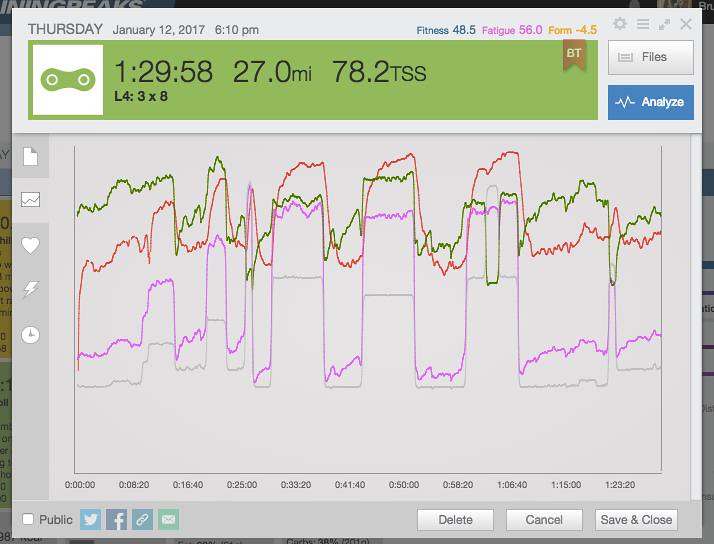Question about heart rate

kamazza
Posts: 98 Member
ok, bit of background. Hubby bought me a Garmin Vivosmart HR for Christmas which is a huge help for me as I have horrid anxieties about heart rates and heart attacks. (I have GAD) anyhoo, so I think I figured out what I want my target HR to be when riding the stationary bike, around 150-155 with short intervals up to 160-165. what I have noticed a few times is that once I've done an interval up to 160-165 it seems much much easier for my heart to get there again. Not sure if that is making sense. but say it takes me 5 minutes to get to 150 (it doesn't but just picking easy numbers) at the start of my work out then takes another 5 minutes to get to 165. fast forward 20 minutes into my work out and now it it might only take 2 minutes to get back to 165. Why? is it because my heart is already at that point so it's easier to get there? or is something really wrong with my heart? (lol, kinda) just curious, I don't really think anything is wrong but inquiring minds need to know.
thanks!!
thanks!!
0
Replies
-
Sounds normal. Is your HR coming back down when you slow down?1
-
Tacklewasher wrote: »Sounds normal. Is your HR coming back down when you slow down?
Yes! it definitely is, it's just so surprising to see it jump up so fast after taking so long the first time around lol0 -
ok, bit of background. Hubby bought me a Garmin Vivosmart HR for Christmas which is a huge help for me as I have horrid anxieties about heart rates and heart attacks. (I have GAD) anyhoo, so I think I figured out what I want my target HR to be when riding the stationary bike, around 150-155 with short intervals up to 160-165. what I have noticed a few times is that once I've done an interval up to 160-165 it seems much much easier for my heart to get there again. Not sure if that is making sense. but say it takes me 5 minutes to get to 150 (it doesn't but just picking easy numbers) at the start of my work out then takes another 5 minutes to get to 165. fast forward 20 minutes into my work out and now it it might only take 2 minutes to get back to 165. Why? is it because my heart is already at that point so it's easier to get there? or is something really wrong with my heart? (lol, kinda) just curious, I don't really think anything is wrong but inquiring minds need to know.
thanks!!
That's very normal. Heart rate lags effort - especially when warming up and doing the first interval. That's why cyclists pay more attention to the Watts when doing intervals, instead of the heart rate. Watts tell you the effort, and the heart rate lag sometimes in the first interval is so long that it will never get up to the reading that you are trying to target.
Example. Tonight after work I had a 90 minute training ride schedule that was to be 30 minutes of warm up, then 3 x 8 minutes in Zone 4 with 4 minutes of easy pedaling between those interval efforts. Even after warming up for 30 minutes, during the first 8 minute interval, my heart rate only reached my "target" at the 7 minute mark - even though my Watts reached the "target" in the first 5 seconds. The second effort the HR made it there by the 4th minute. The third effort, the HR was there by the 3rd minute.
In shorter intervals, HR really lags the effort and I can finish a 2 or 3 minute interval and never have my HR reading reach the intended effort, but the Watts are correct.
2 -
It's always done that. Right? Now you just have visibility to it. Happens all the time, to everything.0
-
That's how my heart behaves, always has since I've been using a HRM (14 years of regular training) - no diagnosed heart issues of any nature. If you're reasonably fit, that's just logical: It takes a while, in a workout, to tax yourself. Once you've done so, for the rest of the workout you're not going back to rested-square-one, you're starting from a semi-taxed state.
The changes I see, as fitness has increased, are that the amount of time/work it takes to first get to HR X increases, and, if I back off the intensity during the workout, my HR drops more rapidly and it will take more work than it used to (when I was in a less fit state) to bring it back up again.
But the phenomenon you mention, 1st achievement of high-ish HR X during a workout is slower to reach than 2nd, 3rd, etc. - happened consistently at all fitness levels (though the quantification of "slow" changes).0 -
It's called "cardiovascular drift". The longer your exercise duration, the more heart rate will "drift" upward, even at the same workload. Several reasons: the increased heart rate itself starts to reduce stroke volume, body temp increase, fluid decrease.
It's very common, but it is almost never mentioned in articles about HRMs or HR training. Heck, it's not even mentioned in a lot of ex phys textbooks.
It's one of the main reasons why I discourage people from using HR interactive workouts on machines. As the workout progresses, the machine constantly decreases workload as HR drifts upward, thus reducing the training quality of the workout.
It's also a problem when people try to be too precise about HR "zone training". You can drift through 2-3 "zones" sometimes in one workout, again without changing workload.5 -
Can u explain workload more? Like what will be workload in case of treadmill or aerobicIt's called "cardiovascular drift". The longer your exercise duration, the more heart rate will "drift" upward, even at the same workload. Several reasons: the increased heart rate itself starts to reduce stroke volume, body temp increase, fluid decrease.
It's very common, but it is almost never mentioned in articles about HRMs or HR training. Heck, it's not even mentioned in a lot of ex phys textbooks.
It's one of the main reasons why I discourage people from using HR interactive workouts on machines. As the workout progresses, the machine constantly decreases workload as HR drifts upward, thus reducing the training quality of the workout.
It's also a problem when people try to be too precise about HR "zone training". You can drift through 2-3 "zones" sometimes in one workout, again without changing workload.It's called "cardiovascular drift". The longer your exercise duration, the more heart rate will "drift" upward, even at the same workload. Several reasons: the increased heart rate itself starts to reduce stroke volume, body temp increase, fluid decrease.
It's very common, but it is almost never mentioned in articles about HRMs or HR training. Heck, it's not even mentioned in a lot of ex phys textbooks.
It's one of the main reasons why I discourage people from using HR interactive workouts on machines. As the workout progresses, the machine constantly decreases workload as HR drifts upward, thus reducing the training quality of the workout.
It's also a problem when people try to be too precise about HR "zone training". You can drift through 2-3 "zones" sometimes in one workout, again without changing workload.It's called "cardiovascular drift". The longer your exercise duration, the more heart rate will "drift" upward, even at the same workload. Several reasons: the increased heart rate itself starts to reduce stroke volume, body temp increase, fluid decrease.
It's very common, but it is almost never mentioned in articles about HRMs or HR training. Heck, it's not even mentioned in a lot of ex phys textbooks.
It's one of the main reasons why I discourage people from using HR interactive workouts on machines. As the workout progresses, the machine constantly decreases workload as HR drifts upward, thus reducing the training quality of the workout.
It's also a problem when people try to be too precise about HR "zone training". You can drift through 2-3 "zones" sometimes in one workout, again without changing workload.It's called "cardiovascular drift". The longer your exercise duration, the more heart rate will "drift" upward, even at the same workload. Several reasons: the increased heart rate itself starts to reduce stroke volume, body temp increase, fluid decrease.
It's very common, but it is almost never mentioned in articles about HRMs or HR training. Heck, it's not even mentioned in a lot of ex phys textbooks.
It's one of the main reasons why I discourage people from using HR interactive workouts on machines. As the workout progresses, the machine constantly decreases workload as HR drifts upward, thus reducing the training quality of the workout.
It's also a problem when people try to be too precise about HR "zone training". You can drift through 2-3 "zones" sometimes in one workout, again without changing workload.It's called "cardiovascular drift". The longer your exercise duration, the more heart rate will "drift" upward, even at the same workload. Several reasons: the increased heart rate itself starts to reduce stroke volume, body temp increase, fluid decrease.
It's very common, but it is almost never mentioned in articles about HRMs or HR training. Heck, it's not even mentioned in a lot of ex phys textbooks.
It's one of the main reasons why I discourage people from using HR interactive workouts on machines. As the workout progresses, the machine constantly decreases workload as HR drifts upward, thus reducing the training quality of the workout.
It's also a problem when people try to be too precise about HR "zone training". You can drift through 2-3 "zones" sometimes in one workout, again without changing workload.It's called "cardiovascular drift". The longer your exercise duration, the more heart rate will "drift" upward, even at the same workload. Several reasons: the increased heart rate itself starts to reduce stroke volume, body temp increase, fluid decrease.
It's very common, but it is almost never mentioned in articles about HRMs or HR training. Heck, it's not even mentioned in a lot of ex phys textbooks.
It's one of the main reasons why I discourage people from using HR interactive workouts on machines. As the workout progresses, the machine constantly decreases workload as HR drifts upward, thus reducing the training quality of the workout.
It's also a problem when people try to be too precise about HR "zone training". You can drift through 2-3 "zones" sometimes in one workout, again without changing workload.
0 -
What's watt?That's how my heart behaves, always has since I've been using a HRM (14 years of regular training) - no diagnosed heart issues of any nature. If you're reasonably fit, that's just logical: It takes a while, in a workout, to tax yourself. Once you've done so, for the rest of the workout you're not going back to rested-square-one, you're starting from a semi-taxed state.
The changes I see, as fitness has increased, are that the amount of time/work it takes to first get to HR X increases, and, if I back off the intensity during the workout, my HR drops more rapidly and it will take more work than it used to (when I was in a less fit state) to bring it back up again.
But the phenomenon you mention, 1st achievement of high-ish HR X during a workout is slower to reach than 2nd, 3rd, etc. - happened consistently at all fitness levels (though the quantification of "slow" changes).
0 -
ah ok, all makes sense then. I consider myself relatively fit as I am a competitive endurance horse rider but I'm overweight so am trying to lose for so many reasons. Cool, I'll keep that in mind
 0
0 -
dexters_dexterity wrote: »What's watt?
Huh? I didn't mention "watt", even though you quoted me (see your post above) - did you mean to quote @SingingSingleTracker instead, who posted this:SingingSingleTracker wrote: »ok, bit of background. Hubby bought me a Garmin Vivosmart HR for Christmas which is a huge help for me as I have horrid anxieties about heart rates and heart attacks. (I have GAD) anyhoo, so I think I figured out what I want my target HR to be when riding the stationary bike, around 150-155 with short intervals up to 160-165. what I have noticed a few times is that once I've done an interval up to 160-165 it seems much much easier for my heart to get there again. Not sure if that is making sense. but say it takes me 5 minutes to get to 150 (it doesn't but just picking easy numbers) at the start of my work out then takes another 5 minutes to get to 165. fast forward 20 minutes into my work out and now it it might only take 2 minutes to get back to 165. Why? is it because my heart is already at that point so it's easier to get there? or is something really wrong with my heart? (lol, kinda) just curious, I don't really think anything is wrong but inquiring minds need to know.
thanks!!
That's very normal. Heart rate lags effort - especially when warming up and doing the first interval. That's why cyclists pay more attention to the Watts when doing intervals, instead of the heart rate. Watts tell you the effort, and the heart rate lag sometimes in the first interval is so long that it will never get up to the reading that you are trying to target.
Example. Tonight after work I had a 90 minute training ride schedule that was to be 30 minutes of warm up, then 3 x 8 minutes in Zone 4 with 4 minutes of easy pedaling between those interval efforts. Even after warming up for 30 minutes, during the first 8 minute interval, my heart rate only reached my "target" at the 7 minute mark - even though my Watts reached the "target" in the first 5 seconds. The second effort the HR made it there by the 4th minute. The third effort, the HR was there by the 3rd minute.
In shorter intervals, HR really lags the effort and I can finish a 2 or 3 minute interval and never have my HR reading reach the intended effort, but the Watts are correct.
0 -
dexters_dexterity wrote: »What's watt?
Watts are way to measure the rate at which work is being done. 1 watt = 1 Joule per second.
The lightbulbs in your house might be 100 watts, or if they're the energy efficient kind they might be 20.
A recreational cyclist puts out about 100 - 200 watts to move their bike around when they ride it. This is the best way for cyclists to measure their effort (and calories) but it's expensive to measure. It's also enlightening to be able to compare the power your body is generating against your heart rate (which is your body's reaction to the work it's doing).dexters_dexterity wrote: »Can u explain workload more? Like what will be workload in case of treadmill or aerobic
Basically the same concept as power output. If you're walking or running on a treadmill, it's the same workload as long as it's the same pace and incline. Higher pace or ramp, more work more quickly.0 -
Having that power measure was huge for me in understanding the HR lag from time of effort as well as HR drift over longer periods of time. Overall I think it helped me a lot in energy conservation as I learned where the extra effort for shorter periods really didn't pay off well in the long run.
Now I tend to set power goals and max HR I feel I should be at for that power output. That sometimes means nudging one or the other.
Watching both also helped me realize how essential it is to warm up properly before a hard output. If I don't warm up and power "out of the gate" too hard, the over time impact isn't worth the elavated HR.0 -
Watts are named after Scottish inventor James Watt. You can read about them here:
http://www.livestrong.com/article/404954-meanings-of-watt-cycling-power-is-high-and-low-good-or-bad/
http://www.lemondfitness.com/training/g-force-bikes/why-train-with-watts
https://www.johnsonfit.com/blog/constant-watts-workouts-build-stamina
Here's an example from my workout on Tuesday. I was to do 6 intervals of 3 minutes duration each in my L5 (Level 5) workload Zone, with 3 minutes rest between of easy pedaling.
The purple line measures the watts, the red line measures the heart rate, and the green line measures the speed. All I focused on was the pink line while doing the intervals due to the lagging heart rate (cardiac drift) to complete my scheduled work.
The next shows Thursday's training ride which was a scheduled 3 intervals x 8 minutes duration in L4 (Level 4) workload Zone with rest between each interval. Same colors as above - pink for watts, red for HR, green for speed - and all I cared about was the pink line or watts while doing the intervals. You can see the HR lag (cardiac drift) a little better in these longer duration intervals. 3 x 8's by BBcamerata, on Flickr 0
3 x 8's by BBcamerata, on Flickr 0 -
dexters_dexterity wrote: »What's watt?
Huh? I didn't mention "watt", even though you quoted me (see your post above) - did you mean to quote @SingingSingleTracker instead.
Yes, I'm sure that's what they meant. I have posted a couple of workout chart pictures that will eventually show up here after some moderator combs through the photos to make sure I own them, they aren't solicitations, naughty, or whatever. Could take 2 - 72+ hours for that, but the two photos will show watts, HR, speed and show the lagging heart rate (cardiac drift) in 3 minute Zone 5 intervals, and 8 minute Zone 4 intervals from my own workouts this week.
1 -
Pictures finally got approved the moderator and posted. Dang it takes a long time for that process which is not a new valuable thing here at MFP - IMO!1
-
The pictures are worth the wait and make me want a power meter!
For me, finding the power level at where the drift becomes more obvious and less linear was a big factor. Having controlled conditions and power measures on the elliptical actually helped a lot on my bike, even though I have much less data on the bike.
I suspect having a power meter would be very strange for me at first. We have no terrain, but frequently have wind. I'm working towards adjusting pace based on perceived exertion in the wind, with the aid of watching where my HR is going. But having the instant input of a meter would really change the game.1 -
robertw486 wrote: »The pictures are worth the wait and make me want a power meter!
For me, finding the power level at where the drift becomes more obvious and less linear was a big factor. Having controlled conditions and power measures on the elliptical actually helped a lot on my bike, even though I have much less data on the bike.
snippage
With apologies to OP for perpetuating thread drift:
This line of discussion has me wondering why watts get essentially no attention in the rowing machine component of rowing coaching. We have the data, but pace and heart rate are the focus. (And despite being an average rower, I've been lucky enough to have some high level coaching, as well as a bunch of coaching education.)
There are some potential good reasons (having to do with the basic point of machine training in the overall program, and the relative role of power in effectiveness on the water), but I need to give the biking similarities and differences some more thought, esoecially in that my personal goals differ from competitive coaches'.
Thanks for the thought-provoking data & discussion.
0
This discussion has been closed.
Categories
- All Categories
- 1.4M Health, Wellness and Goals
- 398.2K Introduce Yourself
- 44.7K Getting Started
- 261K Health and Weight Loss
- 176.4K Food and Nutrition
- 47.7K Recipes
- 233K Fitness and Exercise
- 462 Sleep, Mindfulness and Overall Wellness
- 6.5K Goal: Maintaining Weight
- 8.7K Goal: Gaining Weight and Body Building
- 153.5K Motivation and Support
- 8.4K Challenges
- 1.4K Debate Club
- 96.5K Chit-Chat
- 2.6K Fun and Games
- 4.8K MyFitnessPal Information
- 12 News and Announcements
- 21 MyFitnessPal Academy
- 1.5K Feature Suggestions and Ideas
- 3.2K MyFitnessPal Tech Support Questions







